For five full days, from Feb. 14-18, NAAA exerted great influence in our nation’s capital region, whether it was providing professional training to the next generation of leaders of the aerial application industry, advocating key ag aviation policy positions to federal officials, or outlining substantive policies for the national association to strengthen the industry moving forward.
Leadership Training Program
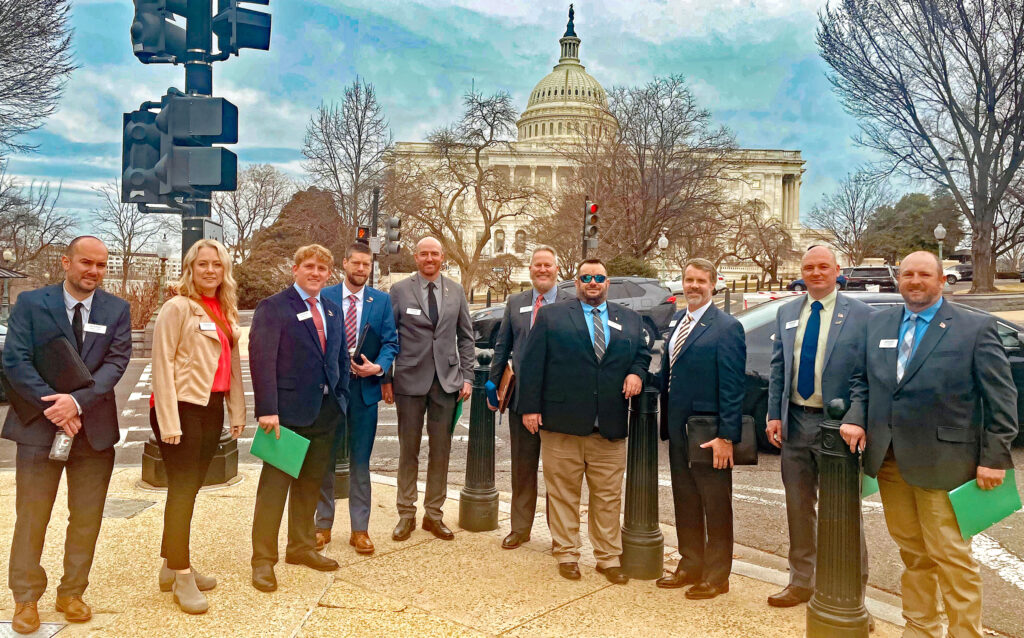
The 26th class of the Leadership Training Program began Tuesday, Feb. 14, where 11 individuals nominated by state and regional ag aviation trade associations underwent professional training in understanding personalities, policy advocacy, and media and communications training for 3 ½ days. The group, along with NAAA board, committee and staff members, spent multiple days advocating ag aviation policy issues to federal policy and lawmakers, including meetings with the EPA advocating for aerial use language on pesticide labels without unnecessary and burdensome label language; and meetings with multiple U.S. Senators and U.S. Representatives on subjects ranging from funding federal aerial application research, eliminating unnecessary and duplicative water permits for applying pesticides under the Clean Water Act when FIFRA already requires pesticides’ safety to water, tower marking and logging requirements, and drone safety requirements.
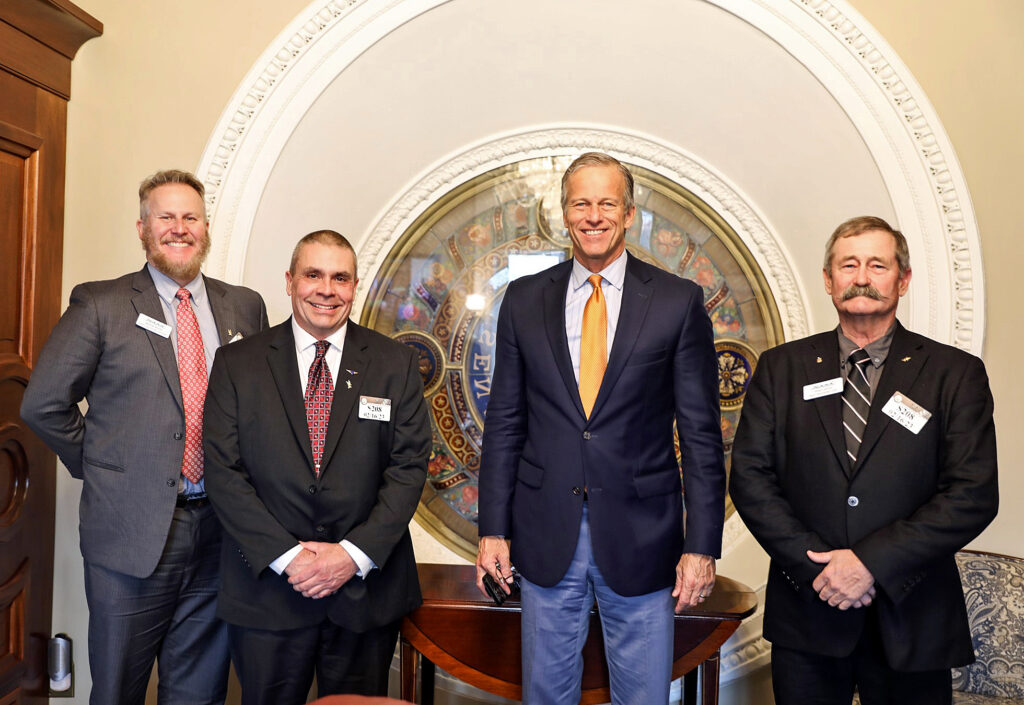
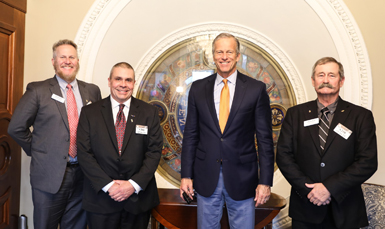

AgAv PAC Breakfast

NAAA hosted its annual fundraiser for its political action committee—AgAv PAC—during its capital area board meeting and was joined at the event by U.S. Sen. Deb Fischer (R-Neb.). Fischer spoke about the upcoming farm bill, which must be authorized this Congress and discussed a particular piece for the bill she is authoring that would provide incentives for farmers that utilize precision agricultural technologies.
EPA
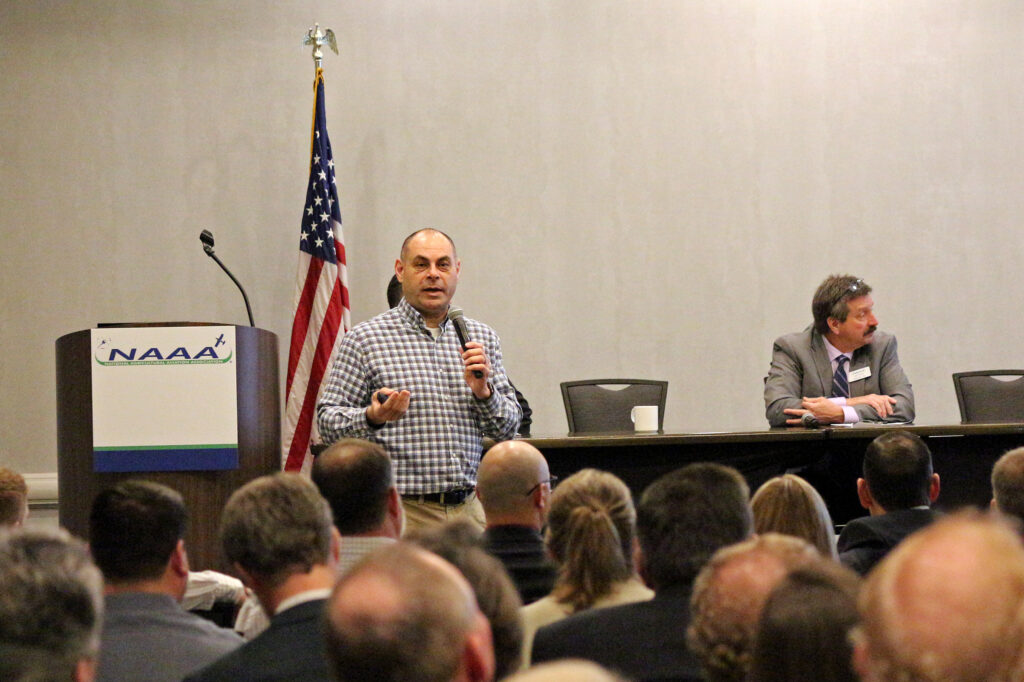
Another key government official addressing the Board was Ed Messina, the director of the EPA’s Office of Pesticide Programs (OPP), which has jurisdiction over approving pesticides on the market and how they may be used. Messina gave a great presentation summarizing the different divisions at OPP and how some weigh the risks and others the benefits of pesticides to formulate their registration and labeling decisions. He also elaborated on the challenges the EPA faces presently, particularly dealing with the Endangered Species Act (ESA) and Section 7(a)(2) of the statute requiring that federal agencies must ensure that the “actions” they authorize will not result in jeopardy or adversely modify designated critical habitat for species listed as endangered or threatened by the U.S. Fish and Wildlife Service (FWS) and/or the National Marine Fisheries Service (NMFS) (jointly the Services). OPP’s “actions” that may jeopardize species are authorizing the sale, distribution and use of pesticides according to the product labeling. The EPA is consistently sued by environmental activists over the ESA. Messina provided several quotes from judges in these cases, such as one from the Center for Food Safety v. Regan, Dec. 2022, 9th Circuit where the judge states, “It’s déjà vu all over again. EPA comes before this court once more because of its failure to abide by the law…. EPA cannot flout the will of Congress—and of the people—just because it thinks it is too busy or understaffed.” The EPA is currently saturated with pesticide decisions that must be reviewed under the ESA.
Messina also stated that OPP is currently evaluating NAAA’s input recommendations for Tier 3 analysis under the AgDRIFT atmospheric model. Tier 3 analysis means further refinements to off-site drift analysis to take into account more specific and refined aerial application inputs, which could allow greater use of specific pesticides as they go through individual risk assessments because of potentially lower modeling of off-site drift.
Messina also stated that OPP is working with several groups to better understand the use of UAVs for pesticide application, such as the EPA PPDC Emerging Technology Working Group, of which NAAA staff are on the group. OPP is trying to better understand the process for updating risk assessment, labels, obtaining additional data, etc. when it comes to UAVs.
CEO Report
Andrew Moore, NAAA CEO, provided an association and industry overview, starting with an economic overview stating that USDA forecasts food price inflation in 2023 to be 7% compared to 2022’s 9.9%. Farm Income in 2023 is forecast to drop $25.9 billion (15.9%) to $136.9 billion from 2022. The drop is partially due to U.S. ag exports, which are expected to decline by $2.5 billion in 2023 from 2022 due to the high value of the dollar versus other global currencies and a current anemic U.S. trade policy. The current administration has been late in getting key trade advisors in position, and China is tapping Brazilian supplies of corn with Ukrainian corn production down due to the conflict with Russia. The U.S. hasn’t taken advantage of corn production losses in the Baltic.
Public policy issues were then discussed, starting with the farm bill, which expires this fall, if it is not extended or reauthorized. NAAA has been lobbying Congress to enact regulatory relief as part of the bill, such as codifying state and federal preemption of enforcing pesticide regulations under FIFRA to prevent a hodge-podge of different county and municipal rules; also pushing a law to exempt pesticide applicators from having to obtain water permits under the Clean Water Act (CWA) since pesticides are already tested for water safety and the Biden administration’s new definition of a Water of the U.S. under the CWA would include ephemeral waters that may not have waters running through them for months if not years. NAAA will also be advocating for federally funded aerial application technology research as part of the farm bill. The fight will be tough to enact a farm bill, especially in the House of Representatives, as deficit hawks square off with food stamp constituencies, which consist of about 80-plus percent of farm bill spending. Federal debt has increased 50% since the last farm bill in 2018 to $32 trillion when $26.3 billion of ag spending was cut.
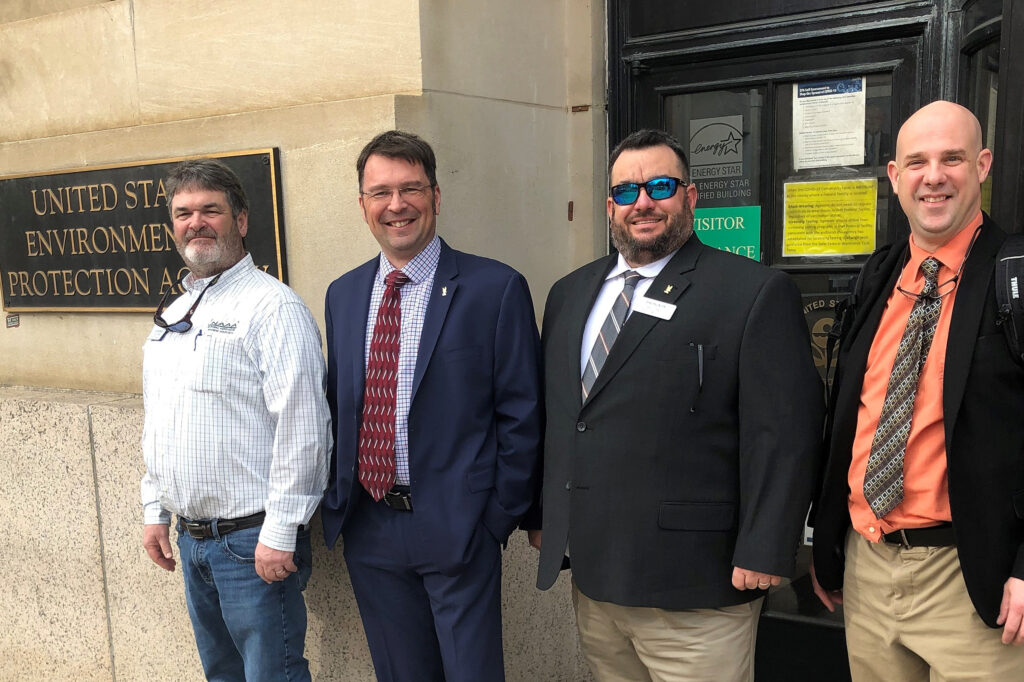
Moore discussed pesticide issues, many of which were discussed by EPA OPP Director Messina. NAAA continues to work to reregister pesticides labeled for aerial use without unnecessary or burdensome label language. Since 2017, NAAA has submitted a total of 257 comments to the EPA to support such uses. Another concept brought to the EPA’s attention during the time the Board was in town was a software concept named site-specific risk assessment. Inputted into the software would be the environmental conditions at the actual spray site (waterbody nearby, endangered species, etc.), then the application equipment used (nozzle, boom width, pressure, etc.). The output would be either additional protections needed for the applicator to implement to protect a sensitive area, or perhaps grant leeway to the applicator, such as allowing for the application to take place in wind speeds more than existing limitations.
Moore also discussed NAAA’s efforts to continue to meet with major chemical manufacturers to register products aerially. Last year it met at UPL, BASF and Syngenta headquarters to meet with top-level officials. This spring it is working on meetings in the Midwest with Bayer and Corteva.
Moore touched on transportation policy issues such as NAAA Board member from Arkansas Matt Woolard’s efforts along to get the Federal Motor Carrier Safety Administration to release a proposed regulation later this year allowing states to transport up to 1,000 gallons of Jet A without a CDL HazMat endorsement. Moore also brought up NAAA’s comments to the EPA to not ban avgas leaded fuel until an alternative is readily available and affordable. He also stated that Congress must pass FAA reauthorization legislation this year, and NAAA will be urging Congress to expand the 2018 statute it worked on requiring both marking and logging of rural towers between 50 and 200 feet tall and 10 feet in diameter or less to apply to all types of towers meeting this description. NAAA will also be working to put in statute language requiring drones to always give right-of-way to manned aircraft.
Moore switched gear to communications. NAAA is proceeding again with its “Above All Forms of Crop Care” ads promoting the agricultural benefits of aerial application and providing the website link for farmers to find NAAA operator members that conduct such services. The ads will be published this spring in Farm Journal Media’s AgWeb newsletter (circulation: 201,000 farmers nationwide), The Scoop magazine (circulation: 20,000 ag retailers and crop consultants nationwide) and Top Producer magazine (circulation: 100,000 large farmers nationwide).
Moore also discussed progress made by NAAA’s Ad Hoc Communications Committee, which is studying ways to broaden NAAA’s focus on external communications after the success of the public relations results of the 100th anniversary celebration. Discussions have been made with publisher Farm Journal to perhaps have ag aviation articles be more present in their widely circulated publications to agriculture. Conversations have also ensued with Marsayl Media about the possibility of providing programmatic marketing services on behalf of NAAA. Programmatic marketing takes data from a web user to program the best web advertisements that best represent that user’s search/viewing behavior. NAAA has also worked with public relations agencies such as the Baering Group and Clyde Group to provide services to broaden the industry’s reach to the larger media.
Accident data was then presented from the recently released 2021 FAA General Aviation Activity Survey. It showed a total of 924,037 ag hours flown that year, with 5.95 accidents per 100,000 hours flown. Those stats showed that our accident rate has continued to decrease since the PAASS Program hit the stage in 1999 by 26.34%. Total accidents in 2022 were 51, sadly, nine of which were fatal. Moore then announced that the Certified Professional Aerial Applicator Safety Steward (C-PAASS) program is now up and running and that those who are NAAA members and belong to a state/regional ag aviation association, along with having completed the past three years of PAASS and gone through an Operation S.A.F.E. clinic over the past two years may now complete their application and receive their 2023 C-PAASS certification at https://education.agaviation.org/cpaass. Craig Craft, the 2023 NAAA president, is the first person to receive the C-PAASS certification. In 2024 additional online training and testing material will be required to become C-PAASS certified.

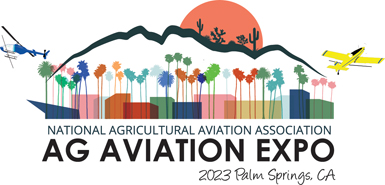 The 2022 Knoxville, Tennessee Ag Aviation Expo was then discussed. It was a profitable show, netting $809,771 for the association, with 1,573 attendees. The 2023 show in Palm Springs, California, is coming together nicely. Aircraft will be flown to Palm Springs International Airport and towed to the convention center. The Kickoff Breakfast speaker will be Burt Rutan, described by?Newsweek?as “the man responsible for more innovations in modern aviation than any living engineer.” He designed the legendary Voyager, the first aircraft to circle the world nonstop without refueling. He also created SpaceShipOne, the world’s first privately funded spacecraft, which won the $10 million Ansari X Prize, offered in an effort to spur the development of affordable space tourism. The 2024 Ag Aviation Expo will be in Fort Worth, Texas, followed by Reno, Nevada, in 2025 and 2028 and Savannah, Georgia, in 2026.
The 2022 Knoxville, Tennessee Ag Aviation Expo was then discussed. It was a profitable show, netting $809,771 for the association, with 1,573 attendees. The 2023 show in Palm Springs, California, is coming together nicely. Aircraft will be flown to Palm Springs International Airport and towed to the convention center. The Kickoff Breakfast speaker will be Burt Rutan, described by?Newsweek?as “the man responsible for more innovations in modern aviation than any living engineer.” He designed the legendary Voyager, the first aircraft to circle the world nonstop without refueling. He also created SpaceShipOne, the world’s first privately funded spacecraft, which won the $10 million Ansari X Prize, offered in an effort to spur the development of affordable space tourism. The 2024 Ag Aviation Expo will be in Fort Worth, Texas, followed by Reno, Nevada, in 2025 and 2028 and Savannah, Georgia, in 2026.
Membership was then discussed. NAAA completed 2022 with a total of 1,826 members—88 more than in 2021 which includes 23 more operator members and 55 more pilot members, although still only 31% of the total number of aerial application operators and non-operator ag pilots in the U.S. As of the end of January, there were 1,129 NAAA members for 2023—423 operators and 323 pilots.
Moore concluded with optimistic forecasts for agricultural production, again citing global population figures of 8 billion humans presently on the planet with 9 billion souls expected by 2050, according to the United Nations. This and the trend of global average temperatures steadily increasing since 1980 to today has increased fungi and other pest pressures in ag and will likely result in more and more demand for pesticide applicators.
Board Meeting
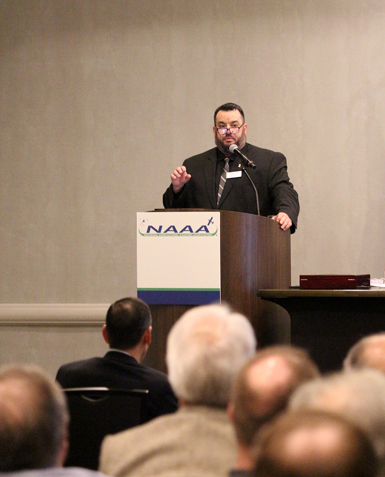
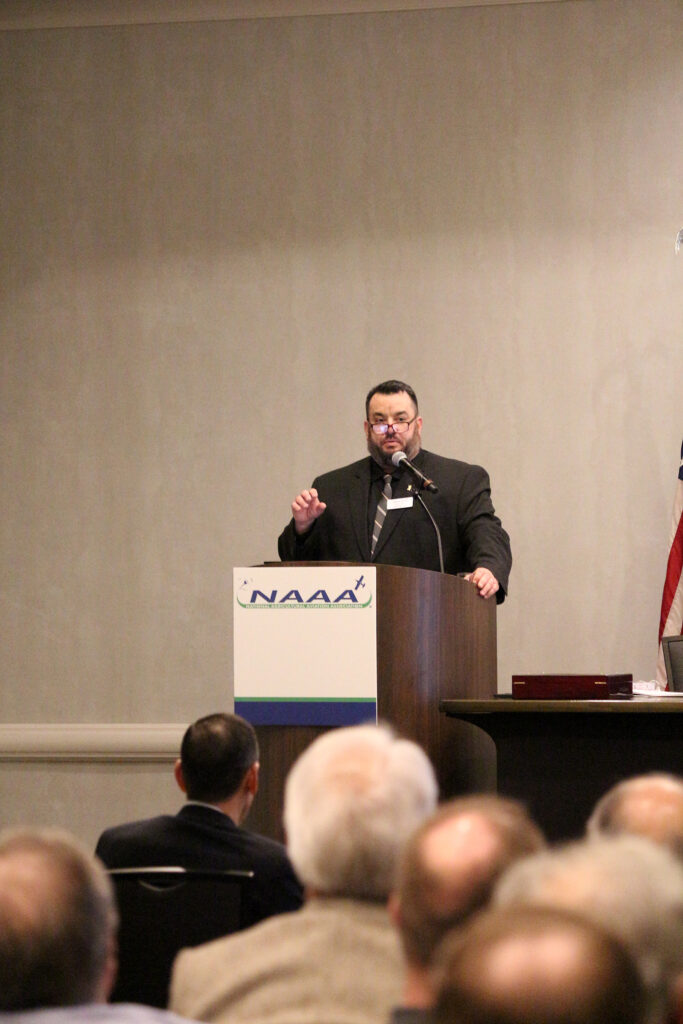
After a busy day-and-a-half of meetings, President Craig Craft presided over the Feb. 18 afternoon NAAA board meeting. The following are business highlights and approved motions from the committees and Board:
Joint Allied & Convention Meeting: The 2022 Knoxville, Tennessee Ag Aviation Expo was a smashing success ranking second in total income received from an NAAA convention. Unfortunately, NAAA had to pay an attrition penalty to one of the hotels due to last-minute cancellations and not filling the room block. To avoid this in the future, NAAA is working with future convention hotels to have a three-week cancellation clause; if a room is canceled within a three-week window of the start of the convention, a one-room-night penalty will be levied and applied to NAAA’s room block.
Palm Spring’s convention this year will include Burt Rutan, the world-famous aeronautical engineer and designer of the Voyager and SpaceShipOne, as the Kickoff Breakfast speaker.
The Board approved a motion by the committee to negotiate contracts for a November 2027 Ag Aviation Expo in Oklahoma City, Oklahoma, based on the offer the city provided the association.
Budget & Finance Committee Meeting: Darrel Mertens, former Treasurer from Colorado, provided an excellent and comprehensive overview of the association’s finances. The total assets for the association equal $5,448,822 and rose $29,638 from last year. As of Jan. 31, 2023, net income for NAAA is $633,561, $50,809 above the prior year.
Mertens also presented a proposed 2023-2024 Fiscal Year Budget. The budget includes underestimating revenues that may be seen from people wanting to be certified under C-PAASS. More convention revenues may also be seen from the convention and wires course, but they were not budgeted. C-PAASS has also seen increased insurance costs and software costs to install learning management software to provide online courses and testing to the tune of $47,000. The budget, ultimately enacted by the Board, has a projected deficit of $192,591.
Communications: Oklahoman Matt Regier, chair of the committee and of its ad hoc panel looking at augmenting external communication activities, reported on a presentation made by AgAir Update’s Graham Lavender on programmatic advertising. This is a system that makes it possible to purchase and place ads, including targeted advertising content, in less than a second on the internet based on the users viewing habits. It is a system the committee is looking at to benefit NAAA by getting the industry messaging out to the right audience.
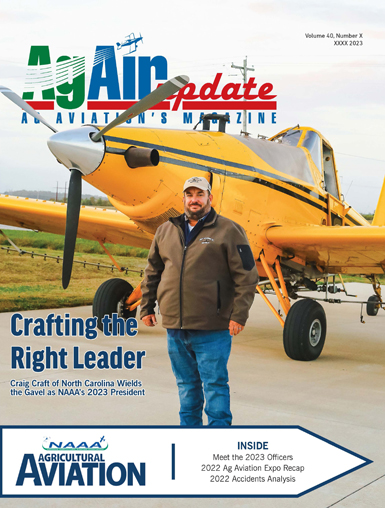 The committee also discussed new publishing opportunities and techniques for the magazine, including partnering with AgAir Update to publish Agricultural Aviation magazine as part of an insert to AgAir Update or a freestanding publication. The committee also discussed Farm Journal publishing the NAAA magazine and possibly having consistent NAAA/aerial application articles in their ag retailer/crop consultant magazine—The Scoop magazine, which has a 20,000-plus circulation.
The committee also discussed new publishing opportunities and techniques for the magazine, including partnering with AgAir Update to publish Agricultural Aviation magazine as part of an insert to AgAir Update or a freestanding publication. The committee also discussed Farm Journal publishing the NAAA magazine and possibly having consistent NAAA/aerial application articles in their ag retailer/crop consultant magazine—The Scoop magazine, which has a 20,000-plus circulation.
To focus more on external communications, as a healthy majority of members and those in the industry were surveyed wanting last spring to positively promote the industry to the public as was done during the recently completed 100th anniversary celebration, the committee brought a motion to the Board to discontinue the summer issue of Agricultural Aviation magazine and bring the number of annual issues from four (4) a year to three (3) a year beginning in 2024. The Board approved the motion.
Government Relations: Chairman Damon Reabe of Wisconsin reported on the government relations issues reported above in the CEO report. He also made a vital point of urging all board members to complete any survey NAAA requests of them and to urge those in their states to do the same. Examples of such surveys include the Raspet Flight Research Laboratory’s request for ag aircraft GPS data to counter drone users’ claims that there is minimal activity at 500 feet or below; a similar survey on obstacle encounters recently released by the University of North Dakota; the NAAA Industry Surveys, etc. The data gathered by these surveys are imperative to NAAA’s advocacy efforts on behalf of the aerial application industry.
Insurance: Chairman Rogge of Colorado reported that the association is looking at the possibility of offering group health insurance to members by researching the services provided by a company named Decisely. Decisely is a technology company partnering with health insurance plans nationwide to effectively create a healthcare.gov type site that may be available to members to choose a health care plan that works for their business or individual pilots if the operator chooses not to offer insurance. The first step to moving forward is to survey the membership and gauge the interest. NAAA would have to use Decisely’s survey and there is a cost. NAAA is looking into this and will report on the cost and move forward if reasonable.
Membership: Louisianan Dwayne O’Brien, Vice President, presented the committee’s report. One very interesting highlight that the committee worked on is the Charles Stokes Memorial Turbine Training Scholarship, a scholarship generously funded by Jim Mills of Turbines Inc. that will provide scholarship funds to a turbine training institution for a low-time ag pilot making the transition to a turbine engine ag aircraft. Applications will be available soon and are due at the end of August. Regarding the Ag Wings of Tomorrow Scholarship, BASF and Thrush have both committed to $10,000 for the 2023 scholarship.
Museum: Matt Woolard of Arkansas informed the Board that the Agricultural Aviation Museum and Hall of Fame in Jackson, Mississippi, is planning phase two renovations which will include a 30-seat theatre. The refurbished Snow S-2A is expected to be delivered in late spring to its final resting place in the museum, and the NAAA’s 100th anniversary book, Agriculture’s Air Force: 100 Years of Aerial Application, is now for sale in the museum’s gift shop. NAAA is working with the Smithsonian to sell the book in its National Air and Space Museum gift shops. The committee discussed and agreed to explore creating a walkway at the museum to memorialize pilots lost to ag aviation accidents. The idea would be to list the names of everyone who has been killed in an ag aviation accident, going as far back as possible, by imprinting their names on pavers placed along an outdoor path at the museum that could be called “The Last Pass Path.” The first step is to research and develop a list of fallen pilots, which Graham Lavender has begun to do. The committee is moving $2,500 from NAAA’s Harold Miller Fund to help finance this project.
Precision Agriculture: The committee discussed Application Insight’s forthcoming nozzle shield caps aimed at reducing small droplets, which is showing promise in reducing drift. Also, Stephen Foster of Foster and Associates Technology Consulting provided an update on current efforts to modernize AgDISP—the atmospheric model determining drift movement. He presented a proposed software development plan which would produce open-source software to use by the EPA, researchers and applicators for autonomous spray systems and the site-specific risk assessment concept. The next step forward is fundraising for this project.
Support: Sue Stewart from New Mexico discussed the topics for the 23-24 Athena program—educational material brought to the state conventions to support ag aviation operations’ crew. The topic next season will be titled “The Five Blades to Propel your Health & Wellness” and will focus on a variety of wellness topics such as hydration, environment, relationships, etc.
The Support’s convention activities in Palm Springs will include a Monday meet-and-greet program to take place at the Palm Springs Air Museum. The Athena program will also be presented during the Ag Aviation Expo. The topic for this year’s Support Committee scholarship is “What value does ag aviation bring to your local economy?” and that information is on the NAAA website.
NAAREF: NAAREF President Perry Hofer of South Dakota announced that the curriculum for the PAASS program is well established, with program content determined for the educational program for the next two years. He also mentioned new funding sources, stating that there are now two state associations sponsoring PAASS at the $5,000 level, qualifying them for an ad in PAASS—Illinois and New Mexico. Hofer also mentioned that the Sunday fundraiser for PAASS, on Dec. 4 at the Ag Aviation Expo, will be karaoke and called “Crooning for PAASS.”
 Concluding Business: Tom May with Nebraska Aviation Trades Association made a $3,000 donation to NAAREF; Sue Stewart with New Mexico announced that their state made a $3,000 donation to NAAREF during the Covington match, and they are now donating an additional $2,000 to NAAREF, for a full $5,000 donation. Don Younglove with Illinois announced that their state made a $5,000 donation during the Covington match.
Concluding Business: Tom May with Nebraska Aviation Trades Association made a $3,000 donation to NAAREF; Sue Stewart with New Mexico announced that their state made a $3,000 donation to NAAREF during the Covington match, and they are now donating an additional $2,000 to NAAREF, for a full $5,000 donation. Don Younglove with Illinois announced that their state made a $5,000 donation during the Covington match.

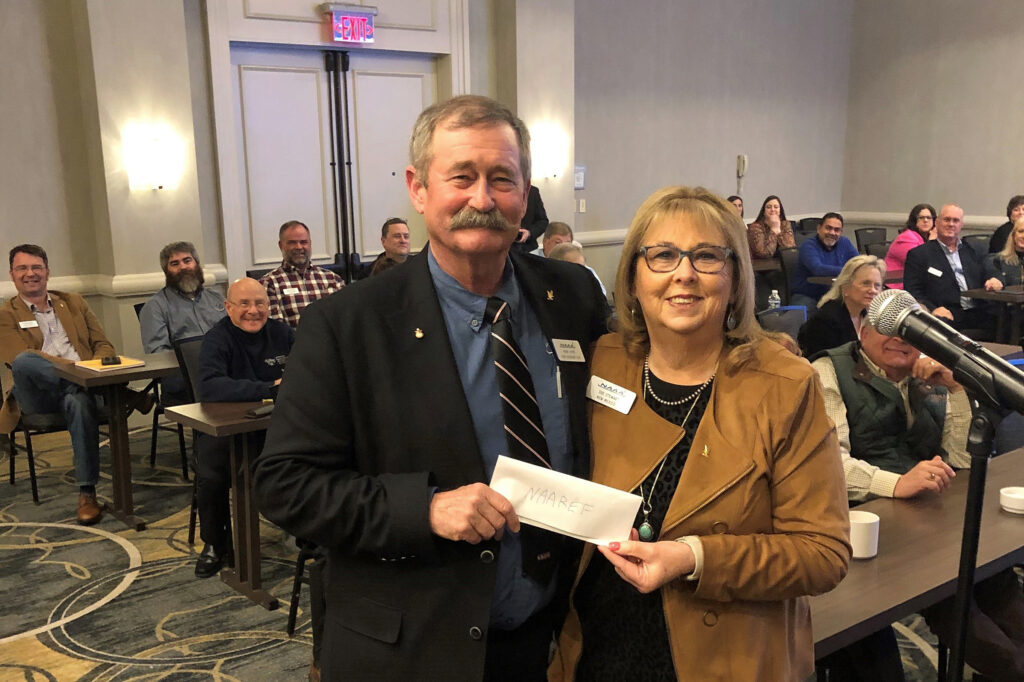
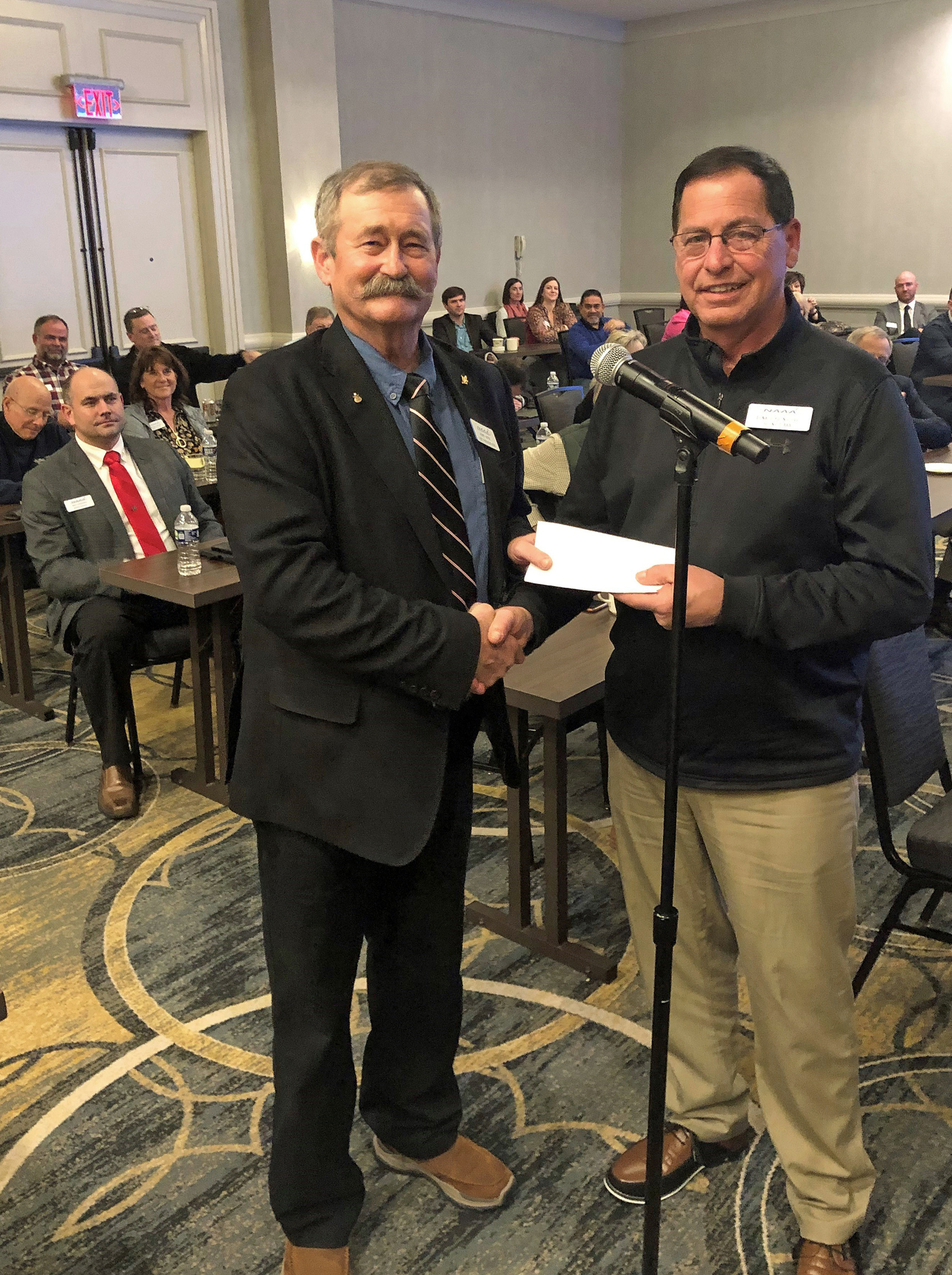
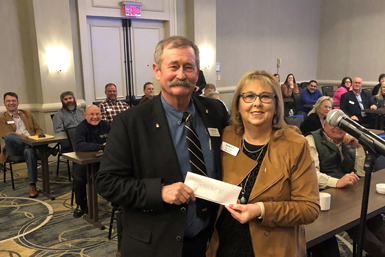
Before adjourning, President Craft recognized the leadership training program participants. He also reminded the Board of Directors of key takeaways from the meeting:
- Remind people in your state to book in the room block for the Ag Aviation Expo.
- Nominate a member for an award from your state/regional association.
- Complete the surveys that NAAA sends to members.
- Remind your state/regional members to turn in GPS data to the MSU Raspet study.
- Remind your state operators and pilots to join NAAA and the state/regional association.
- Consider hosting the Athena Project at your state/regional conventions.
- Sponsor a Support scholarship applicant. Also, check out the new Charles Stokes Memorial Turbine Training Scholarship.
- Challenge your state/regional association to donate to NAAREF.





